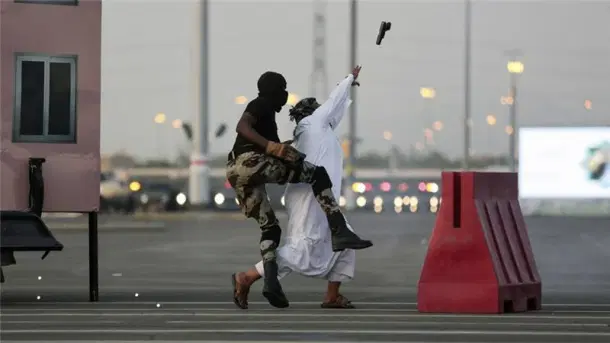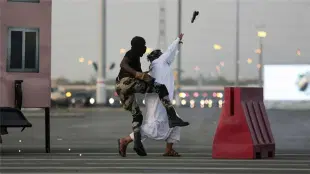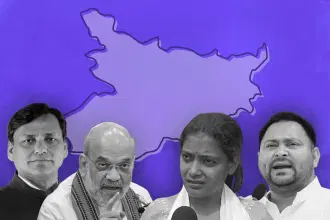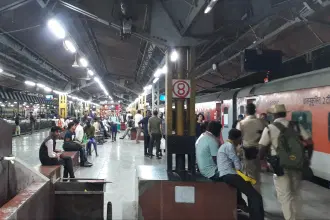Commentary
Hindu Terror? Malegaon Acquittals Show How Suspicion Became The Sentence For Hindus
Nabaarun Barooah
Aug 04, 2025, 02:35 PM | Updated 03:18 PM IST
Save & read from anywhere!
Bookmark stories for easy access on any device or the Swarajya app.


On 29 September 2008, a motorcycle laden with explosives detonated near Bhikku Chowk in Malegaon, a communally sensitive town in Maharashtra. The explosion killed six people instantly and left over 100 injured.
In the immediate aftermath, investigators speculated about Islamist involvement, given Malegaon's history of previous blasts allegedly tied to jihadist groups. But within a month, the narrative took a jarring turn. The Maharashtra Anti-Terrorism Squad (ATS), led by Hemant Karkare, arrested seven Hindu individuals, including Sadhvi Pragya Singh Thakur and Lieutenant Colonel Prasad Purohit.
This marked the first time that the phrase “Hindu terror” entered mainstream Indian discourse, where terrorism had a primarily Islamist face. The arrests shocked the nation, especially given Purohit’s position in military intelligence. It became a political firestorm. Opposition parties questioned the motives, while others cited it as proof of rising “saffron radicalism”.
Yet, on 31 July 2025, seventeen years later, a special National Investigation Agency (NIA) court acquitted all accused, citing lack of evidence, procedural lapses, and manipulation of facts. The case, which had distorted public imagination and political narratives for over a decade, collapsed.
But in its collapse, it exposed a far graver truth: the dangers of the Congress' politicised investigation, institutional coercion, and the state’s power to criminalise through narrative.
Anatomy of a Flawed Case
The ATS presented a swift and seemingly well-constructed theory: a Bajaj motorcycle owned by Sadhvi Pragya had been used in the bombing, and calls made between her and others pointed to a larger Hindu nationalist conspiracy.
It linked the blast to Abhinav Bharat, a fringe radical outfit formed to retaliate against Islamist attacks on Hindus. The ATS named eleven individuals, eight of whom were arrested early on.
But the foundation was shaky from the start. The motorcycle’s chassis number had been scratched off, and later reports suggested it was either planted or misidentified. Despite being central to the investigation, this detail was never satisfactorily resolved. There was no CCTV footage from the blast site.
Explosives were initially said to be RDX, a material difficult to procure without military access, strengthening the case against Purohit. But forensic reports later questioned this claim, indicating that the explosive mixture was inconsistent with RDX, and lab protocols were flouted.
Statements from key witnesses were also problematic. At least 39 witnesses eventually retracted or modified their statements in court, alleging coercion, threats or inducements during the ATS probe. One witness claimed he was forced to sign blank papers. Another ATS officer claimed to have been forced to name Mohan Bhagwat.
A crucial procedural failure involved the application of the Unlawful Activities (Prevention) Act (UAPA). The requisite sanctions were either defective or missing, rendering parts of the prosecution's case legally unsustainable. Further, medical records purportedly showing the nature of injuries or the presence of explosives on bodies were found to have been manipulated.
The NIA, which took over in 2011, re-investigated and concluded there was no credible evidence linking the accused to the crime. Yet the damage had already been done. Reputations were destroyed, years were lost in prison or under house arrest, and media trials framed individuals long before a court could assess their guilt.
The Special NIA Court’s 2025 verdict was not merely an exoneration. It was an institutional indictment. The court's language was firm: suspicion, however grave, cannot substitute evidence.
It observed that the ATS had failed to build an unbroken chain of evidence and pointed out glaring gaps in the investigation, including procedural irregularities, contaminated crime scenes and fabricated testimonies.
The court was particularly scathing about the abuse of UAPA. The stringent provisions of the Act, which allow for extended custody and denial of bail, were used to detain the accused for years without trial. In many ways, the process itself became punishment. This misuse of an anti-terror law revealed how laws designed to protect the state could be repurposed to serve political ends.
Public response was sharply polarised. Some saw the acquittals as vindication of justice long denied; others lamented that the state had bungled an important terrorism case.
The media, which had run sensational headlines branding the accused as “Hindu terrorists”, offered little in the way of apology or accountability. Civil liberties groups expressed concern over investigative overreach, while political leaders across party lines remained largely silent, reflecting perhaps an unspoken consensus that it was best to let the case quietly disappear.
The verdict ultimately forced India to confront an uncomfortable question: when the state wields its investigative power to shape political narratives, who protects the individual from institutional overreach?
The Rationalist Murders and the Culture of Obstruction
The Malegaon case stands not in isolation but within a broader ecology of politicised investigations. Between 2013 and 2017, India witnessed the murders of four high-profile “rationalist thinkers”: Narendra Dabholkar, Govind Pansare, M. M. Kalburgi, and Gauri Lankesh.
All were vocal critics of religious dogma, superstition and ‘extremist Hindutva ideology’. All were killed by unidentified or semi-identified assailants using a similar modus operandi: close-range shooting, two-person bike squads and absence of robbery motive.
Dr Amit Thadani’s The Rationalist Murders: Diary of Ruined Investigation offers a haunting chronicle of how these investigations unfolded, and more often, unravelled. Investigators often started with leads that pointed to fringe Hindu groups. Key suspects were arrested, and often for unrelated petty crimes that were retrofitted to match the murder profile.
In the Dabholkar case, the police charged persons who had gone missing ages ago. In other cases, critical forensic evidence, including CCTV footage, mobile tower data and eyewitness accounts, was either delayed, lost or dismissed. Even sketches were forged and changed.
Thadani argues that investigative agencies, whether through incompetence or ideological allegiance, subverted justice. The cases became politically inconvenient; the victims were painted as “controversial”; and the killers remained largely faceless. Most of these botched investigations aimed at painting an image of “saffron terror” and took place under Congress-NCP rule.
The Malegaon and rationalist cases demonstrate the same pathology. When ideology overrides investigation, the state no longer seeks truth but affirmation of a preferred script. This institutionalised haste to blame a pre-decided ideological enemy echoed in all these high-profile cases.
Amit Thadani notes that investigating agencies deliberately ignored alternate leads and rushed to charge Hindu nationalist groups in the killings of rationalists. Specific investigative failures — tampered diaries, withheld call records and selective leaks — pointed not to incompetence alone, but to intentional narrative-building.
At the heart of these botched investigations lies a deeper civilisational fault line: the strategic conversion of the Hindu into India’s “default suspect”. In the Malegaon case, the term “saffron terror” was not just descriptive. It was doctrinal. It allowed politicians, journalists and academics to project a false equivalence between Hindutva and jihad, between the Bajrang Dal and Lashkar-e-Taiba, between a cultural resurgence and a death cult.
That equivalence was essential. Without it, the UPA government would have had no counterweight to the rising public anger over Islamist terrorism between 2004 and 2008. And hence, they even tried to frame the RSS for conducting 26/11.
But the social consequences of that framing were dire. Hindus, particularly those with religious or nationalist affiliations, became vulnerable to prosecution by suggestion. A saffron robe became a red flag. A military uniform became grounds for suspicion. And this was not limited to Malegaon.
In the "rationalist" murder cases, the accused were often fringe figures or loosely affiliated individuals, but entire Hindu traditions were tarred in the process. The target was not merely a person; it was a civilisation seen as resurgent, assertive, and therefore threatening.
The danger here is existential. When investigative systems begin to mirror ideological biases, justice becomes selective and memory becomes manufactured. Those who wear a tilak, quote the Gita, or serve in the Army may find themselves ensnared not by law, but by narratives.
Suspicion Was the Sentence
The 2025 acquittals in the Malegaon blast case should have shaken the nation. Instead, they were met with silence. Not because the case lacked significance, but because its collapse exposed something too uncomfortable for the ecosystem that created it: that an entire community was placed on trial not for what it did, but for what it symbolised.
For nearly two decades, a monk, a soldier, and others wrongly accused lived under the weight of allegations so grave they upended their lives, health, reputations and liberty.
The court has now ruled that there was no evidence to connect them to the crime. But the damage is done. In the theatre of public perception, suspicion itself became the sentence.
When law enforcement agencies subordinate truth to ideology, whether in the case of Malegaon or in the bungled probes into rationalist murders, they do more than fail the individual. They fracture the republic. They turn justice into a performance and secularism into selective outrage.
The Malegaon case was not an investigation. It was a warning. A warning about how fragile institutional integrity becomes when ideology sits in the judge’s chair, when the media plays prosecutor and when the citizen is stripped of presumption of innocence by the colour of his robe.
The judiciary has now spoken. But unless those who peddled the myth of Hindu terror are held accountable politically, institutionally, intellectually, the cycle of narrative-driven injustice will repeat. And the next innocent, too, will first be blamed and only then investigated.





